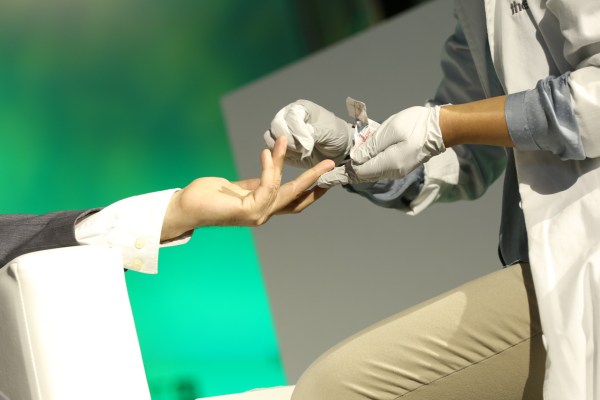Silicon Valley blood-test technology startup Theranos has once again responded to allegations made by the Wall Street Journal over questionable test results. Unfortunately, little of that response has to do with the allegations.
Theranos founder Elizabeth Holmes has been on a selective media tour to do damage control over a WSJ report alleging the company wasn’t using its own tech for most of the 240 tests it provides.
Theranos denied those claims in a blog post Thursday morning and Holmes spoke almost exclusively to CNBC host of Mad Money Jim Cramer Thursday evening, saying she was “shocked” at the WSJ story and telling Cramer that questioning her claims to a technology that makes blood testing quicker, easier, painless and less-expensive was, “what happens when you work to change things, and first they think you’re crazy, then they fight you and then all of a sudden you change the world.”
Holmes also told Cramer, who readily admitted he’d never heard of Theranos before the interview, that she’d sent over 1,000 pages of documents to prove the technology behind her company, but that the Journal declined to use that information.
When asked, the Journal told TechCrunch that it, “fully stands by John Carreyrou’s article about Theranos, which was richly sourced and thoroughly researched.”
Carreyrou claimed sources inside told him Theranos was using venous draws on machines from Siemens and other companies, rather than its own technology on the majority of its tests and that many of the test results from its own machine were way off. The Journal also claimed sources told the news organization that only 15 of the 240 tests were being run through Edison, Theranos’ proprietary machine.
The Journal published a second piece Thursday evening alleging Theranos was only using its technology on one of the more than 200 tests it offers. Holmes told Bloomberg in a one-on-one interview at the Vanity Fair conference the week before that the company was indeed using its proprietary technology on one test.
However, in a second post since the Journal published its piece, Theranos wrote, “We are disappointed to see that The Wall Street Journal still can’t get its facts straight.”
Theranos admitted in the Friday afternoon post that its “nanotainers,” which are small vials used for collecting a tiny amount of blood for tests ranging from HIV to diabetes, were currently being used for just one test to detect the herpes virus and that it was working with the FDA to approve more tests voluntarily, which, rather than correcting the Journal piece, corroborated the earlier WSJ rumors.
Theranos also didn’t clear up other allegations made in the Journal piece. Instead, it lashed out at the Journal and explained the three-step process by which blood is collected on its platform:
Here are the facts:
There are just 3 steps to Theranos’ groundbreaking finger-stick technology.
1. Take a few drops of blood.
2. Put the blood in the Nanotainer™ tube.
3. Analyze the blood.That’s it. 3 simple steps. 1, 2, 3.
This is curious, as the methods by which Theranos simplified the process of testing was not generally in question in the Journal piece or in other reports. Those largely focused on the accuracy of the results and the technology behind the test itself, rather than the vessel.
Theranos also spoke of “unprecedented transparency,” referring to its disclosure of the exact costs of its blood tests and that it was working with the FDA. But the statement does not directly address the science behind or accuracy of its test results – in my mind the latter two are pretty important and have yet to be addressed.
“Unprecedented transparency – in price and in submitting our data to FDA. Groundbreaking technology. Gold standard review. 1, 2, 3,” reads Friday’s statement.
That’s great Theranos is asking for FDA clearance and hopefully other biotech companies dealing with significant tests results relating to our health do the same. However, what we really need from Theranos is scientific transparency.
An early critic of Theranos technology, Stanford medical professor John Ioannidis pushed the importance of transparency in the company’s methods as well, and urges Theranos to show us published papers, raw data, and proper protocols to judge the technology by. “In the absence of this, I am afraid that we will see more of the nebulous uncertainty that is communicated in the WSJ article. I am afraid that it will become a battle of anecdotes of poor performance versus press releases stating everything is great. Perhaps this is how journalism and PR work, but this is not how science works,” he told TechCrunch in response to the new Theranos statement.
We’ve reached out to Theranos and have been told we were ‘allowed’ to “quote freely from [the latest post], and attribute it to Theranos.” Ok, Theranos.
Maybe we’ll get better answers the next time the company writes a post.
